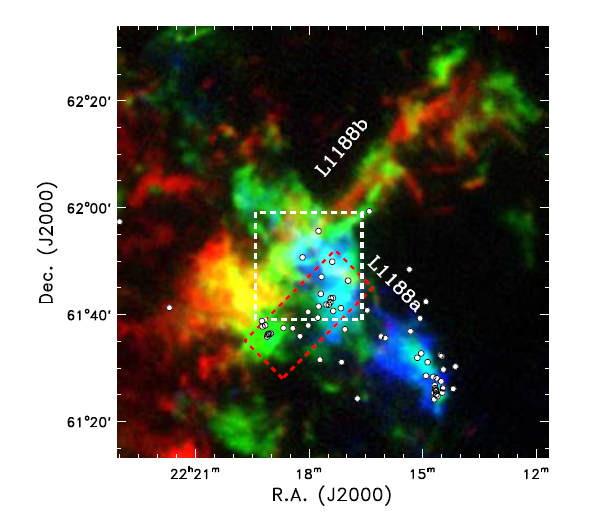Theoretically, cloud-cloud collisions have been proposed to play an important role in molecular cloud evolution, star formation, and, on a grander scale, in galaxy evolution. Identifying cloud-cloud collision is indispensable in order to verify theories.L1188 is one of the most promising cloud-cloud candidates. Additional observational features of cloud-cloud collision will be beneficial for robust identifications. We carried out observations of multiple molecular lines toward the intersection region of the two nearly orthogonal filamentary molecular clouds, L1188a and L1188b (see Figure 1).

Figure 1. Overview of L1188. The observed region is indicated by the white dashed box. The white circles represent the young stellar object candidates associated.
Based on these observations, we find two parallel filamentary structures, both of which have at least two velocity components being connected with broad bridging features. We also found a spatially complementary distribution between the two molecular clouds (see Figure 2), as well as enhanced 13CO emission and 12CO self-absorption toward their abutting regions.
At the most blueshifted velocities, we unveil a 1 pc-long arc ubiquitously showing 12CO line wings. We discover two 22 GHz water masers, which are the first maser detections in L1188. An analysis of line ratios at a linear resolution of 0.2 pc suggests that L1188 is characterised by kinetic temperatures of 13–23 K and H2 number densities of 103–103.6 cm?3. On the basis of previous theoretical predictions and simulations, we suggest that these observational features can be naturally explained by the scenario of a cloud–cloud collision in L1188, although an additional contribution of stellar feedback from low-mass young stellar objects cannot be ruled out.
The paper was published inAstronomy and Astrophysics(Gong, et al. 2019, A&A, 632, A115). Detailed information of the paper can be found at https://www.aanda.org/articles/aa/abs/2019/12/aa36824-19/aa36824-19.html
